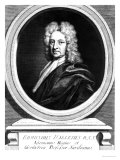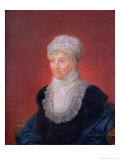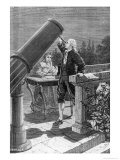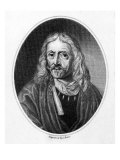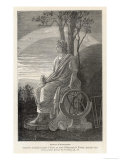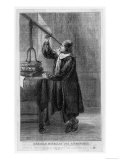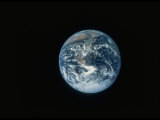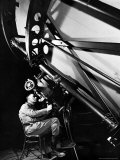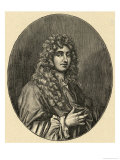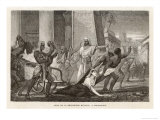|
|
|
|
|
Fred Haise
b. 11-14-1933; Biloxi, MS
Fred Haise, one of the 24 people to have flown to the Moon, was part of the Apollo 13 mission. He was also the test pilot for the Space Shuttle Enterprise that was used for approach and landing tests (never in space.)
|
|
|
|
Sir Edmond Halley
b. 11-8-1656; London, England
d. 1-14-1742
Sir Edmond Halley was an astronomer, geophysicist, mathematician, meteorologist, and physicist. He is most noted for his prediction of the return of a comet in 1758, officially known as 1P/Halley, the most famous of the periodic comets (due to brightness and 75-76 year periodicity which was within the range of a human life span). Halley's mathematical work also contributed to actuarial science and history of demography.
FYI ~ American author Mark Twain was born in 1835, a year of Halley's Comet appearance, and died in 1910, on the next occassion of the comet's appearance.
Edmund Halley quotes ~
• “In the year 1456 ... a Comet was seen passing Retrograde between the Earth and the sun... Hence I dare venture to foretell, that it will return again in the year 1758.”
• “This sight... is by far the noblest astronomy affords.”
• “Aristotle's opinion... that comets were nothing else than sublunary vapors or airy meteors... prevailed so far amongst the Greeks, that this sublimest part of astronomy lay altogether neglected; since none could think it worthwhile to observe, and to give an account of the wandering and uncertain paths of vapours floating in the Ether.”
• “I earnestly wish them all imaginable success; in the first place that they may not, by the unseasonable obscurity of a cloudy sky, be deprived of this most desirable sight; and then, that having ascertained with more exactness the magnitudes of the planetary orbits, it may redound to their eternal fame and glory.”
• “Scarce any problem will appear more hard and difficult, than that of determining the distance of the Sun from the Earth very near the truth: but even this... will without much labour be effected.”
• Edmond Halley: Charting the Heavens and the Seas
|
|
|
|
Bernard Harris
b. 6-26-1956; Temple, Texas
Astronaut and physician Bernard Harris is the first African American to perform an extra-vehicular activity (spacewalk) in 1995, during the second of his two Space Shuttle flights.
|
|
|
|
Caroline Herschel
b. 3-16-1750; Hanover, Germany
d. 1-9-1848
Caroline Herschel, the sister and full time assistant of William Herschel, lived most of her 98 years in England. She was the first woman to discover a comet; the recognition earned her an annual salary from King George III.
• women scientists
|
|
|
|
William Herschel
b. 11-15-1738; Hanover, Germany
d. 8-25-1822; Slough, Berkshire, England
(Notice who's standing behind her brother; at least she was acknowledged!)
William Herschel was a German born musician and composer who was also a noted astronomer for his discovery of the Planet Uranus in 1781, and infrared radiation.
William Herschel's son, Sir William Herschel, is credited with coining the word “photography” c. 1839.
|
|
|
|
Johannes Hevelius
b. 1-28-1611; Danzig (Gdansk), Poland
d. 1-28-1687
Johannes Hevelius, a political official in Danzig (Gdansk), Polish-Lithuanian Commonwealth, was also an astonomer and is known as the “Founder of Lunar Topography”.
Hevelius is thought to be the last astonomer to do major work using only the quadrant and alidade in his own private observatory. “Prodomus Astronomiae” was published in 1690.
• Johannes Hevelius and His Catalog of Stars
|
|
|
|
Hipparchus
b. c. 190 BC – c. 120 BC
Hipparchus, the first Greek astronomer whose models of the Sun and Moon survive, is considered the greatest observer of the skies in antiquity, and the inventor of the astrolabe. Hipparchus most likely made use of the observations and mathematical techniques of the Chaldeans from Babylonia and, in turn, the work of Claudius Ptolemaeus relied on the work of Hipparchus.
Hipparchus was also a geographer, and a mathematician.
|
|
|
|
|
|
|
Fred Hoyle
b. 6-24-1915; Gilstead, Bingley, West Yorkshire, England
d. 8-20-2001 (stroke)
Astronomer and mathematician Fred Hoyle is remembered best for his contribution to the theory of stellar nucleosynthesis as well as his controversial stance on other cosmological matters such as the“Big Bang” theory, a term he originally coined on BBC radio.
In addition to his work as an astronomer, Hoyle was a writer of science fiction.
Fred Hoyle quotes ~
• “Once a photograph of the Earth, taken from the outside, is available, a new idea as powerful as any in history will be let loose.”
• “Space isn't remote at all. It's only an hour's drive away if your car could go straight upwards.”
• “It is in the world of ideas and in the relation of his brain to the universe itself that the superiority of Man lies. The rise of Man may justly be described as an adventure in ideas.”
• “It has often been said that, if the human species fails to make a go of it here on the Earth, some other species will take over the running. In the sense of developing intelligence this is not correct. We have or soon will have, exhausted the necessary physical prerequisites so far as this planet is concerned. With coal gone, oil gone, high-grade metallic ores gone, no species however competent can make the long climb from primitive conditions to high-level technology. This is a one-shot affair. If we fail, this planetary system fails so far as intelligence is concerned.”
• “When I was young, the old regarded me as an outrageous young fellow, and now that I'm old the young regard me as an outrageous old fellow.”
• “The creationist is a sham religious person who, curiously, has no true sense of religion. In the language of religion, it is the facts we observe in the world around us that must be seen to constitute the words of God. Documents, whether the Bible, Qur'an or those writings that held such force for Velikovsky, are only the words of men. To prefer the words of men to those of God is what one can mean by blasphemy. This, we think, is the instinctive point of view of most scientists who, curiously again, have a deeper understanding of the real nature of religion than have the many who delude themselves into a frenzied belief in the words, often the meaningless words, of men. Indeed, the lesser the meaning, the greater the frenzy, in something like inverse proportion.”
|
|
|
|
Edwin Hubble
b. 11-20-1889; Marshfield, MO
d. 9-28-1953; California
Edwin Hubble, an American astronomer, was head of the Mount Wilson Observatory from 1919 until his death. Hubble was the first astronomer to prove the Universe is expanding. The orbiting Hubble Telescope is named for him.
Edwin Hubble quotes ~
• “Equipped with his five senses, man explores the universe around him and calls the adventure Science.”
• “Science is the one human activity that is truly progressive. The body of positive knowledge is transmitted from generation to generation.”
• “The history of astronomy is a history of receding horizons.”
• “Past time is finite, future time is infinite.”
• “We find them smaller and fainter, in constantly increasing numbers, and we know that we are reaching into space, farther and farther, until, with the faintest nebulae that can be detected with the greatest telescopes, we arrive at the frontier of the known universe.”
• “With increasing distance, our knowledge fades, and fades rapidly. Eventually, we reach the dim boundary — the utmost limits of our telescopes. There, we measure shadows, and we search among ghostly errors of measurement for landmarks that are scarcely more substantial. The search will continue. Not until the empirical resources are exhausted, need we pass on to the dreamy realms of speculation.”
|
|
|
|
Christiaan Huygens
b. 4-14-1629; The Hague, The Netherlands
d. 7-8-1695
Christiaan Huygens was a Dutch astronomer, physicist and mathematician. Noted as instrumental in the "scientific revolution", Huygens discovered Saturn's moon Titan, observed Saturn's rings were made up of rocks, wrote a book on probability theory encouraged by Pascal and made significant contributions to timekeeping. Huygen's contributions to space exploration is commemorated in the Cassini-Huygens Saturn & Titan probe.
A crater on Mars and a mountain on Earth's Moon is named after Huygens.
|
|
|
|
|
|
previous page | top | next
people in astronomy list | a | b | c | d-e-f | g | H | i-j-k-l | m | n-r | s | t-z
|
|
I have searched the web for visual, text, and manipulative curriculum support materials - teaching posters, art prints, maps, charts, calendars, books and educational toys featuring famous people, places and events - to help teachers optimize their valuable time and budget.
Browsing the subject areas at NetPosterWorks.com is a learning experience where educators can plan context rich environments while comparing prices, special discounts, framing options and shipping from educational resources.
Thank you for starting your search for inspirational, motivational, and educational posters and learning materials at NetPosterWorks.com. If you need help please contact us.
|
|
|








